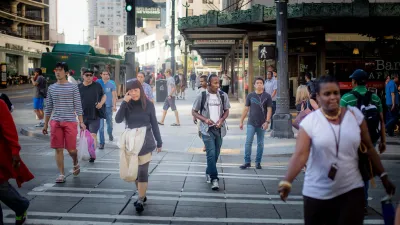New census data shows that millennials and seniors are migrating less, a result of the Great Recession and its economic impacts. For those who are moving, cities in the Sun Belt have been primary destinations.

Demographer William H. Frey writes about the migration trends of millennials and Baby Boomers after the Great Recession, evident in new American Community Survey data. Migration rates for both groups slowed during and after the recession, reflecting the job and housing challenges millennials have faced and the delayed retirement and relocation limitations of seniors, says Frey.
Migration magnets for millennials are largely Sun Belt cities in the South and West. Baby Boomers also have headed to the Sun Belt, but none of the top five cities for each group overlapped, notes Frey. While both groups are leaving high-cost metropolitan areas, particularly on the coasts, millennials are spreading out across the country while seniors are focusing on the more traditional retirement states of Arizona and Florida.
"Millennials are more mobile than their elders and more apt to shift with changing opportunities, particularly to areas with knowledge based economies. In contrast, those seniors who do move are zeroing in on a smaller set of exclusively Sun Belt destinations that have long been associated with retirees, warm climates and recreation," concludes Frey.
FULL STORY: How migration of millennials and seniors has shifted since the Great Recession

National Parks Layoffs Will Cause Communities to Lose Billions
Thousands of essential park workers were laid off this week, just before the busy spring break season.

Retro-silient?: America’s First “Eco-burb,” The Woodlands Turns 50
A master-planned community north of Houston offers lessons on green infrastructure and resilient design, but falls short of its founder’s lofty affordability and walkability goals.

Delivering for America Plan Will Downgrade Mail Service in at Least 49.5 Percent of Zip Codes
Republican and Democrat lawmakers criticize the plan for its disproportionate negative impact on rural communities.

Test News Post 1
This is a summary

Test News Headline 46
Test for the image on the front page.

Balancing Bombs and Butterflies: How the National Guard Protects a Rare Species
The National Guard at Fort Indiantown Gap uses GIS technology and land management strategies to balance military training with conservation efforts, ensuring the survival of the rare eastern regal fritillary butterfly.
Urban Design for Planners 1: Software Tools
This six-course series explores essential urban design concepts using open source software and equips planners with the tools they need to participate fully in the urban design process.
Planning for Universal Design
Learn the tools for implementing Universal Design in planning regulations.
EMC Planning Group, Inc.
Planetizen
Planetizen
Mpact (formerly Rail~Volution)
Great Falls Development Authority, Inc.
HUDs Office of Policy Development and Research
NYU Wagner Graduate School of Public Service




























